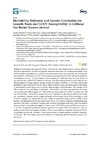Please use this identifier to cite or link to this item:
https://accedacris.ulpgc.es/jspui/handle/10553/70182
| Title: | Heritability estimates and genetic correlation for growth traits and LCDV susceptibility in gilthead sea bream (Sparus aurata) | Authors: | Carballo, Carlos Shin, Hyun Suk Berbel, Concepción Zamorano Serrano, María Jesús Borrego, Juan Jose Armero, Eva Afonso López, Juan Manuel Manchado, Manuel |
UNESCO Clasification: | 251092 Acuicultura marina 310902 Genética |
Keywords: | Diseases Genetic Selection LCDV Sea Bream |
Issue Date: | 2020 | Journal: | Fishes | Abstract: | The lymphocystis disease (LCD) is a viral infection with a high economic impact in gilthead sea bream aquaculture. In this study, genetic estimates associated with lymphocystis disease virus (LCDV) disease susceptibility and growth were determined in sea bream juveniles. Two fish batches (named batch 1 and batch 2) were built from mass spawning and reared under industrial conditions until disease outbreak. At the moment of the sampling (n = 500 specimens for each batch), all animals had the typical LCDV lesions in the skin. For phenotyping, animals were weighted and photographed for image analysis (surface covered and lesion intensity). LCDV DNA copies were quantified in the liver by qPCR. Batch 1 had a higher surface covered and lesion intensity than batch 2, and the body caudal region was the lowest affected region in both batches. The average LCDV DNA copies in liver were higher in the batch 1 than batch 2, and they were positively correlated with severity index (SI) categories (r2 = 0.90–0.94). The total number of families evaluated were 150 and 128 for batch 1 and batch 2, respectively, with a high bias in offspring contribution by family and broodstock. Heritabilities for weight and length were 0.18 and 0.14 in batch 1 and 0.06 and 0.05 in batch 2, respectively. Heritability for the number of viral DNA copies was low (<0.08) in both batches. Heritabilities for SI in binary scale were 0.32/0.33 and 0.21/0.24 (underlying liability/Bayesian approach) for batch 1 and batch 2, respectively. Genetic correlations were very high and positive when growth traits (weight and length) or disease traits (LCDV DNA copies and SI) were compared. In contrast, the genetic correlations between growth and disease traits were moderate–high and positive in the batch 1 but negative in batch 2. These results indicate the genetic selection for LCDV susceptibility and growth is feasible in sea bream juveniles, although estimates are highly dependent on the age. The information provided is relevant to designing selective breeding programs in sea bream. | URI: | https://accedacris.ulpgc.es/handle/10553/70182 | ISSN: | 2410-3888 | DOI: | 10.3390/fishes5010002 | Source: | Fishes [2410-3888], v. 5 (1) |
| Appears in Collections: | Artículos |
SCOPUSTM
Citations
8
checked on Jun 8, 2025
WEB OF SCIENCETM
Citations
7
checked on Jun 8, 2025
Page view(s)
90
checked on May 23, 2024
Download(s)
128
checked on May 23, 2024
Google ScholarTM
Check
Altmetric
Share
Export metadata
Items in accedaCRIS are protected by copyright, with all rights reserved, unless otherwise indicated.
